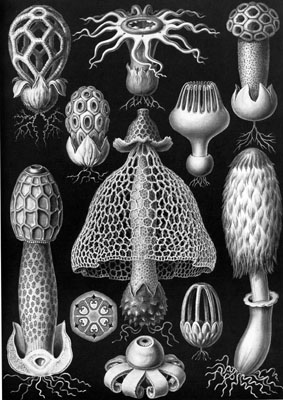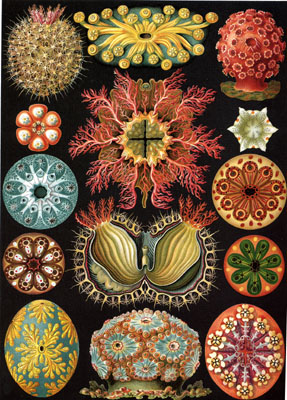Visual Reference Library
I go to books when I need to stimulate my imagination. Books never fail. I am a visual thinker, even ...
I go to books when I need to stimulate my imagination. Books never fail. I am a visual thinker, even when I write words, so I especially respond to visual books full of images, graphs, and pictures. Over the years I’ve accumulated a pretty good library of visual source books. Today, used books are cheap. You can build a good library of inspiration rather easily and inexpensively. These reference books will be the last to be replaced by digital screens, and they will still work perfectly well in the next century — no obsolescence. If you can find space to keep them, a good reference library is a working treasure.
I probably have several hundred visual reference books, so I will list only the two dozen or so that I would truly hate to loose. I am mostly omitting single-artist retrospective books, including my favorites, since these are easier to find than the ones I include here, which are not obvious and less well-known.
— KK
Parallel Encyclopedia
Batia Suter, 2007, 592 pages

A fat encyclopedia of thousands of pictorial gems taken from old books. These old-timey results won’t show up on Google image search. Each page is a wonderful orthogonal view of our world– Items are roughly grouped by category. It’s a constant source of amazement, kind of a visual curiosity cabinet.


*
Secret Museum of Mankind
David Stiffler, 1999, 576 pages

This hefty softcover is a facsimile collection of thousands of exotic and sensational photographs dating from around the turn of the century when news of any sort from far away lands was rare. It’s sort of a combination of early uncensored National Geographic and Ripley’s Believe It or Not. Reproduced without a known author, or copyright, or even authentication of the captions, it was for many years a “secret” underground publication. And for pure gawking pleasures it still can’t be beat. Cannibals, executioners, and fakirs, oh my! I use it as a mighty sourcebook of amazing costumes, body modifications and hairdos, architectural novelties, and extinct strange rituals. (I’m convinced science fiction film directors mine this for alien worlds.) I like to think of this book as the best one volume catalog of cultural diversity on Earth. For the most part these societies are long gone, and remain only in rare books like this one.


*
Art Forms in Nature
Ernst Haeckel, 1998, 139 pages

Long a favorite of designers, this 1904 album is a library of possibilities. Its etchings depict lesser-known life forms as drawn by the German naturalist Ernst Haeckel. These organisms appear to be from an alien planet, although they are all found on earth, in soil or water. They contain the future forms of cars, gadgets, architecture, and so this book will serve anyone thinking of the future. Artists, engineers, and natural scientists have used this album for inspiration for the past century. The Dover edition of the book shows all 100 pages in black and white; while the slightly more expensive Prestel edition shows the 25 pages that are in color, and the other 75 in their original black and white.


*
Natural Art Forms
Karl Blossfeldt, 1998, 128 pages

Similar to Haeckel’s book, but primarily close ups of plants and seeds. There is an other-worldly aspect to these organic forms, in monumental black and white. A great inspiration for sculpture and 3D thinking.


*
Open Here
Paul Mijksenaar and Piet Westendorp, 1999, 144 pages

I thought I was the only one in the world stealing the safety instruction cards from airline seats because of their terrific graphics. Apparently others see the genius of language-free charts. For radically clear thinking nothing can beat a really good set of wordless diagrams; you know, the kind found as instructions for assembling furniture, or opening a container. They have a rarified beauty. Hundreds of examples from around the world are paraded here.


*
The Deep
Claire Nouvian, 2007, 256 pages

Photographs of fishes and invertebrates from the deepest parts of the Earth’s oceans. The forms, colors and appearances of these distant species are so warped by the deep pressure and blackness they they might as well be machines made on another planet, and as such they can ignite alternative ideas in the reader.


*
How to Wrap Five Eggs
Hideyuki Oka, 2008, 224 pages

Packing has always been a high art in Japan, even for the most lowly common article. These studio photographs of traditional Japanese packaging from the 1950s and 60s capture Japanese creative packing at its peak before it was sidelined by plastic and printing. With the advent of 3D printing, we may return to this tactile stunning and elegant practice. This book will serve as a starting point for anyone interested in innovative packaging.


*
Fantastic Illustrations of Grandville
Jean-Ignace-Isidore Grandville, 1987, 156 pages

Surreal and whimsical did not start with hipsters. These book of 266 pen and ink illustrations by the Parisian Jean Grandville in the early 1800s depicts fantastical chimera, and phantasmagorical visions. It’s old-timey hallucinogenic scenes, often switching animals for people. Always guaranteed to wake you up.


*
Art Cars
Harrod Blank, 2012, 160 pages

Why are cars so boring, uniform in color, undecorated, unpersonalized when they could be…. covered in pennies, painted in polka dots, or traced in iron? You’ve probably seen an art car on the road and smiled. This is one of several albums of homemade art car culture by Harrod Blank. If you can improve cars this way, you can do it with toasters and the rest of the stuff in Walmart.


*
Auspicious Designs of China
Ye Yingsui, 2004, 239 pages

A small paperback crammed full of vernacular designs of traditional China taken from throwaway paper cutouts, stencils, wood block carvings and front door banners. A great and varied collection, all in black and white. Good for logos and such.


*
1894-95 Montgomery Ward
Jr. Joseph J. Schroeder, 1977, 600 pages

A page by page reproduction of the mail order catalog from Montgomery Ward in the winter of 1894-95. You get a snapshot of *everything* that was made at that time, plus the description of the item in text. Everything as in: screws, bolts, carpets, curtains, toys, guns, hats, pins, books, tractors, saddles, bullets, bicycles and buggies. It’s a time machine and museum in a book.

*
Street Graphics India
Barry Dawson, 2001, 112 pages

This book inspired me to begin recording street graphics as I traveled so now I have my own collection, but this modest book will give anyone a good representation of the graphic landscape in India — from Bollywood billboards, to painted rickshaw covers, matchbox covers, wall advertisements, signage, and household symbols.


*
Infinite Worlds
Vincent Di Fate, 1997, 320 pages

Past visions of the future. Several thousand science fiction book covers and illustrations (sorted by artist) from past decades. This is the imagination unleashed.


*
Sensacional! Mexican Street Graphics
Juan Carlos Mena, O Reyes, 2002, 339 pages

A thousand amazing wall ads, hand-painted signs, and posters from the streets of Mexico. Tons of energy, color, wit and boldness. Opening this brick of a book is opening a cornucopia of folk art.


*
African Ceremonies
Carol Beckwith, 1999, 744 pages

This two-volume oversized celebration of contemporary ritual in Africa is shocking in its lushness. It seems to explode with possibilities of what ritual and ceremony could be, of how many different ways there are to find meaning in life. It captures the artistic genius found in traditional Africa, now vanishing. There’s a one-volume smaller paperback selection called Passages: Photographs in Africa, which presents highlights from Ceremonies. But this abridgment has only one-tenth the 850 images in Ceremonies, and I feel it misses the point of the larger work: glorious, extravagant diversity.


*
Street Art San Francisco
Annice Jacoby, Carlos Santana, 2009, 304 pages

A deep and wide collection of the best of San Francisco’s murals. A bit of hippy style, plus Mexican, plus punk, plus hipster. Great mix, hundreds of examples.


*
Full Vinyl
Ivan Vartanian, 2007, 164 pages

Vinyl figurines and toys are the latest fashionable collectables. Designer toys are being propelled by cheap manufacturing, and will be accelerated even further by 3D printing, which makes it possible for almost anyone to make small objects. There’s plenty to study. Among the several vinyl toy books I have this one has the widest range of material, including much from Japan.



*
An Album of Fluid Motion
Milton Van Dyke, 1982, 176 pages

Spirals. Vortices. Waves. Cyclones. Turbulence. Ripples. An engineer collected 400 of the classic photographs of hydraulic movement he could find in old scientific volumes and self-published a reference book for engineering students. He’s been surprised that mostly artists, animators and poets have been buying it. I’m not surprised.


*
1000 Record Covers
Michael Ochs, 2005, 576 pages

This is merely one in a whole series of “1,000 X” visual references that Taschen publishes, but it is my favorite for several reasons: For years the most innovative graphic design in the world was featured on record covers, and now this art has vanished from view. Also, this collection of 1,000 covers is part of a personal collection of 100,000 albums, and these 1K are curated by the owner not for the album’s graphic beauty but for their musical and cultural influence, so one gets a whole spectrum view of the art as well. Catalogued roughly by decade, from the 50s, through the 80s.


*
Russian Criminal Tattoo Encyclopedia
Danzig Baldaev, 2006-2009, 400 pages each

In three volumes! Tattoos in the Russian prison system were coded messages meant to communicate to other prisoners the wearer’s status and gang affiliation, to send insults to the guards, to scare innocents, and as badges of accomplishment for the owner. Russian prison tattoos thus contain multiple layers of subcultural references which give them strange and disturbing powers. Russia’s prison system was so vast, indigenous, and generational that prisoners had their own verbal language, culture, and iconography. For instance many of the pornographic tattoos were punishments doled out to losers of card games who could not pay. There are so many levels to these tattoos that they were officially collected and copied by the authors in order to decipher them. Each one is a small bomb of meaning; as visual source material you can’t have more power than these.


*
Masters of Deception
Al Seckel, 2007, 320 pages

In one tome, a glorious collection of visual trickery, the best I’ve seen. Optical illusions of the most ingenious types — using mirrors, type fonts, murals, globes, junk, and of course paint. It is a grand gallery of nerd art and visual wit.


*
1000 Steampunk Creations
Dr. Grymm, Barbe Saint John, 2011, 320 pages

Steampunk is a contrarian reaction to the sleek minimalism of modernity and the “nothingness” of an iPod. It takes inspiration from the visible workings of brass pipes, rivets, and gears of Victorian technology and transfers that maximalism — how many doo-dads, filigree, extra decorations can one add? — to artifacts and clothing today. While this extreme counter-style is dated (by definition), it holds many potential ideas. This one volume compendium contains a thousand vibrant examples of excessive transparency.


*
Fantasy Worlds
John Maizels, Deidi Von Schaewen, 1999, 335 pages

Sometimes, despite all pressures toward normalcy, people are compelled to construct their own worlds. The old lady who over the years arranges broken bottles into a house, or the man down the road covering his barn with tiny quotes from a channeling spirit–each glues raw symbols into a whole that makes sense for them. This happens all over the world. I’ve collected an entire stack of books about self-made worlds, and this one is the best for sheer exuberance, geographic inclusion, and variety.


*
Dover
922 Decorative Vector Ornaments, 2009, 48 pages

For 50 years Dover Publications has been selling cheap editions of copyright-free clip art. Their inexpensive books are still a great bargain for reams of images at low cost, and their catalog is impressive — calligraphy, old letterpress fonts, folk stencils, celtic knots, bygone engravings, you name it. I have a fair number of Dover clip art books and wish I had more. Recently Dover has issued some of their art books with companion CDs to save you the trouble of scanning the material. Their newest offerings include a CD with vector graphics of the images, which means you can re-size them without losing detail or acquiring distortions. In 5-years CDs will be obsolete, and perhaps then Dover will sell downloads online. In many ways their clip art paperbacks are a sensible investment, since they can always be scanned, and I find thumbing through a book the most efficient way to scan a large collection.









